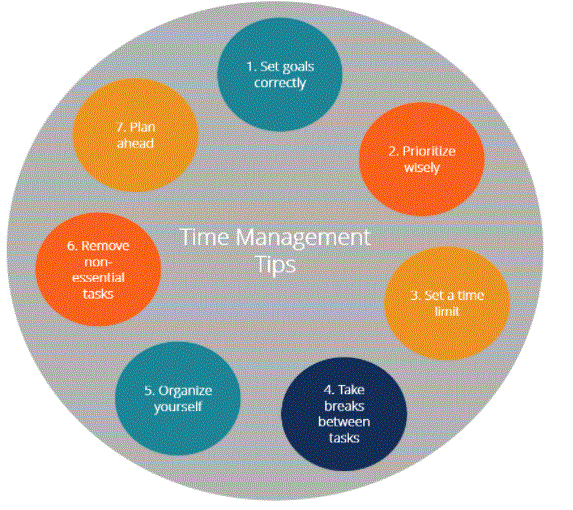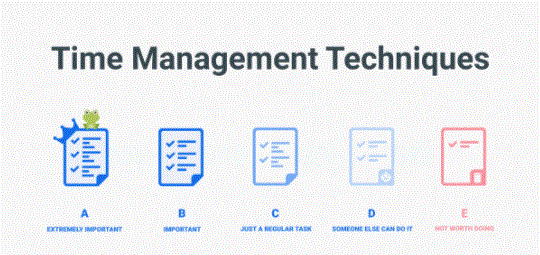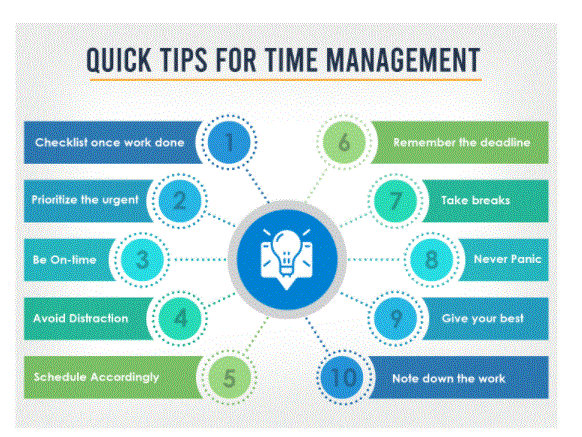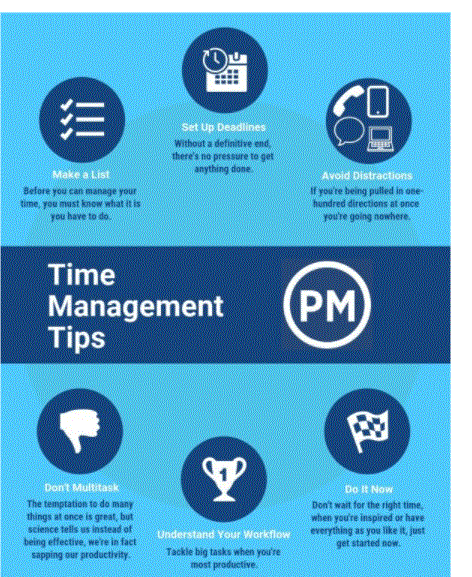
Time management is the process of organizing and planning how to divide your time between different activities. Get it right, and you’ll end up working smarter, not harder, to get more done in less time – even when time is tight and pressures are high. The highest achievers manage their time exceptionally well.
- Introduction to Most Effective and Proven Time Management
- How Does Time Management Help?
- Time Management Techniques
- What is The Best Way to Manage The Time?
- Other Time Management Techniques
- Deep Work & GTD Technique
- ABCDE & Time blocking & Time boxing & Day theming Technique
- Task Batching & RPM & 80/20 Rule Technique
- Smart Goals & 1-3-5 rule & POSEC & Glass Jar & 4Ds Technique
- Conclusion
Introduction to Most Effective and Proven Time Management:
Time management is something that some people struggle for, while others are champions of productivity. No problem, to really master it, you need to know how to do it right. And the internet is full of tips, tricks and methods. But they may not always work. You have to find the ones that have been proven and used by time management experts.
Times can be tough. And therefore, it is important to know how to fit your work and daily activities into it. If you struggle with managing your work or want to experiment with your current methods, check out our list of the most effective and proven time management techniques.

- You will be able to accomplish the goals successfully it will be easier to set priorities
- You’ll end up with bad habits like not being goal-oriented, procrastinating, or having a short attention span
- Developing time management skills will reduce stress and keep you motivated
- You will have a clear idea of how you should plan all your actions
- Additionally, developing the right time management skills in the workplace and using dedicated apps can increase your chances of staying on top.
How Does Time Management Help?
The concept of time management has gained significant popularity over the past three decades. This is because it helps in better planning and organising activities, increasing productivity and maintaining a healthy work-life balance. So how does time management improve performance? The main goal is to consciously control how you spend time on important tasks and activities, whether at work or in your personal, daily life.
Mastering the right time management techniques can help you in several areas:
- The concept of time management has evolved gradually and now covers many topics related to work and daily life. All kinds of theories have been mixed with techniques and approaches. People like to adopt and adjust them according to their needs, type and working style.
- However, there is a significant difference between time management and methodology used to manage work. This is especially visible in large organisations that need to streamline business processes for better results and higher performance as well as to meet the high demands of customers and clients.
- Task management includes time management as one of its concepts is to optimise the time required to deliver a product while maintaining efficiency and quality. It includes professionally co-related exercises, rules and specific procedures set out in logical order that you can reuse and adjust for the better performance of your team.
- Some popular methods or frameworks (also known as project management techniques) for managing work include Kanban, Scrum, Agile, Lean or Six Sigma. Overall, time management techniques based on task management systems are commonly used by many people to manage work time, but with broader aspects such as the full scope of work in a project, workflow, teamwork and Cooperation.
Time Management Techniques:

- Fancy calendar and personal organiser, either digital or in paper form
- Time Management Apps & Tools
- Dedicated To-Do-Lists
- Post-it-Notes, Notepads, Bullet Journals, and Other Paper Forms for Time Managers
- The Morning Sidekick Journal—A Motivational Journal That Helps Change Habits
- You can mix, add and adjust various options to master your time management.
- Checking and responding to emails is a cumbersome task. Nobody likes it, yet everyone does it. Statistics say that “the average worker spends about 30 hours a week checking email.” Think of all the things you could have done during that time.
- Minimise the amount of time you spend on e-mail to keep those 30 hours for work. If you check it in the morning, answer only the most important ones that need an immediate answer. Leave the rest for breaks between tasks or go through them at the end of the day. Also, be sure to mark those unimportant messages as “spam” so they don’t dump your inbox.
- If you want to learn more about managing email, read about “Inbox Zero” technology. This is one of the most popular time management strategies for email management.
- Some people are early birds, while others are night owls. We are all different and like to work in different parts of the day or night.
- Sam Carpenter, author of the book Work the System: The Simple Mechanics of Making More, coined the term biological prime time. It describes a time management technique where you find your most productive hours of the day and schedule work when you have the most energy.
- If you are most productive in the morning then get up early. Or if you prefer to work in the dark, stay up late at night. But don’t force yourself to change your habits because it is said that people reach productivity at certain times. Find your most productive hours and stick to them. Whatever time management strategy works for some people, it might not work for you. Duration. And don’t forget about the intense work phase—a time during your work hours when you focus only on the important tasks.
- Mark Twain said, “If it’s your job to eat frogs, it’s best to do it first thing in the morning. And if your job is to eat two frogs, it’s best to eat the largest one first.”
- It is all about prioritising. Do the most important tasks first, and when you’re done, switch to those less relevant tasks. This will help you organise the workflow better and you will be efficient. Its as simple as that!
- Working without a break can do you more harm than good. We need breaks so that our mind can be refreshed and then focus on work.
- You can use the Pomodoro Technique, or go for a short walk. Read a chapter from your favourite book or make a cup of coffee. Or spend your free time watching some new documentary movies on video streaming platforms like Netflix. You can use a VPN to get a reliable connection.
- Take breaks and feel refreshed to improve your time management techniques. This will give you a significant productivity boost.
- Of course, when you have a super-powerful flow it’s okay to work in a long string sometimes. But doing so in the long term will make you feel tired and your creativity will decrease. Breaks are good for your productivity and wellbeing.
- And for employees, remember that you are entitled to leave. This is your right and the employer is bound to abide by it. If you are unable to obtain leave, contact the appropriate legal entities in your state.
- Everyone has their limit. We can’t do everything that people want from us. This will lead to irritation and work anxiety. That’s why it’s so important to be assertive and say “no” when people want to assign you extra tasks.
- Remember, there is nothing wrong with refusing to do the things you are not capable of doing. As well as delegating tasks. Especially if there is someone who can do the job better and faster than you.
- Notifications, pop-up messages, e-mails, coworkers constantly talking to you. All this takes your attention away from work.
- There are many ways to stay focused. You can put your phone away, turn off social media notifications, or block distracting websites.
- But the best way is to focus and do what you have to do. Minimising your presence in social media is worth it as it takes a lot of your time and doesn’t bring much value to your life.
- Set goals and you will know where you are headed. Goals are part of organisational processes and they are extremely important in time management.
- To take advantage of any time management technique, the key is specificity when setting goals. Break down visions into monthly goals to hit.
- For example, if you’ve decided to start your own online boutique this year and your goal for the semester is to generate $80k in revenue, then this month’s goal is to close a contract with 2 wholesalers, to help with shipping. Hiring and searching for an intern may be necessary. Marketing channel with lower cost of acquisition than your current channel.
- Goals determine your path to reach success. They range from leader to top. Goals determine your organisation.
What is The Best Way to Manage The Time?
According to research conducted by Vikas Academy, only 1 in 5 people (18%) have a proper time management system. In other words, many people don’t know how to be productive. But with a little help, you can be the master of your time. Here are popular time management techniques that you can use to improve your time management skills.
1. Plan your day in advance
Planning is the first, best and most proven technique of all time management techniques. Firstly, because it helps to organise your work properly. Secondly, because it gives you detailed information about everything you need to do. If you can plan your daily, weekly or monthly tasks, the rest comes easily.
There are several ways to plan and organise your work:
2. Limit Email Intake
3. Find Your Productivity Zone
4. Eat Frogs
5. Take Regular Breaks
6. Say “No” and Delegate
7. Stay focused and block out distractions
8. Set Goals

- The Pomodoro Technique is a time management technique invented by Francesco Cirillo in the late 1908s. As the name suggests, the technique uses the popular Pomodoro Timer as a tool in determining time constraints.
- Its objective is to manage time effectively and focus on a single task
- The Pomodoro Technique consists of 4 “pomodoros” – intervals of 25 minutes separated by breaks. When Pomodoro is finished, you take a 5-minute break. After this, you sit for another 25 minutes and keep repeating this action. After completing the 4-Pomodoro cycle, you take a long break.
- Pro Tip: You can use time tracking software with a 25-minute timer to accurately track your time with the Pomodoro Technique. This way, you will automatically get your work report.
Other Time Management Techniques:
Many popular time management techniques are based on practical approaches that aim to complete tasks within a specific time frame and in a specific way. Over the years, various methods have emerged that help in improving management skills and increasing efficiency. Here are other good time management techniques used by people around the world. Take a look, choose your favourites, mix, combine and adjust them to increase your productivity!
Pomodoro Technique:
Eisenhower matrix:
The Eisenhower Matrix is a time management technique created by the 34th President of the United States, Dwight D. Eisenhower. The method helps to prioritise tasks based on urgency and importance, while sorting out the less urgent and important tasks that you should either delegate or not do at all.
In this technique, you create 4 quadrants with the following ranges:
Do first: Do important things first
Schedule: Schedule every less urgent but still important task for later
Delegate: Delegate (if possible) important but less important tasks to others
Don’t: Don’t do things that are neither urgent nor important
- The intensive work method has already been mentioned, but it is a popular technique that should be considered. Cal Newport, author of Deep Work: Rules for Focused Success in a Distracted World, distinguishes between deep work and shallow work.
- During the intense work phase, you focus only on the important task and avoid distractions at all costs. So no phone calls, social media, meetings and other distractions. This fixed period in your schedule is good when you have a high energy level. For shallow work time, do smaller tasks that don’t require you to focus intensely, eg, routine tasks, emailing, etc.
Deep Work & GTD Technique:
Deep work
GTD (Getting Things Done)
Developed by David Allen and described in his books, the Getting Things Done method is one of the most widely and successfully adopted time management systems. The idea of GTD system is to clear your mind about all the tasks, projects and issues and take specific action to complete them. This is an effective five-step method:
Capture : Write or record everything in any form that gets your attention
Clarify : Decide what to do with it—the do’s, don’ts, or delegate
Organise : File tasks into different categories; Use task management tools and to-do lists to make sure you’re making progress
Reflect : Get regular updates on your work to make sure you’re on track and nothing boggles your mind
Stay Engaged : Take Actionable Steps to Be Accountable for Your Time

- The ABCDE method was invented by Alan Butler and is mentioned in his book “How to Get Control of Your Time and Your Life”. It can help you prioritise tasks and optimise the time required to complete them.
- You put an A (most important), B (important), C (to do well), D (rep), or E (remove whenever possible) next to each task or activity and prioritise them according to the letters. give.
- Each time a new task appears, you should add it to your ABCDE task list.
- Time Blocking is a simple time management technique that helps you become aware and strategic about how you spend your time. In time blocking, you divide your day into time blocks.
- During these blocks of time, you focus on a specific task and do it with a set deadline (for example, “I will answer emails from 9 a.m. to 10 a.m.”). It’s like putting your to-do list on the calendar and dragging it out throughout the day.
- Day-theming is another branch of time blocking. In this technique, you time-block your weekly schedule with a work theme for each day. So your daily schedule is dedicated to specific tasks from one category.
- For example, on Monday you have a day spent planning and organising work and taking care of administrative work; Tuesday – a day devoted to working in intensive work mode on a specific task; On Wednesday you can dedicate to education etc.
ABCDE & Time blocking & Time boxing & Day theming Technique:
ABCDE
Time blocked
Time boxing
Time boxing is similar to time blocking; However, in time boxing you set a specific deadline for a task (for example, “I will have all emails answered by 10 AM”). This is a more strict version of blocking time.
Day theming

- In this method, you group similar tasks together and block out your day to work on them. You can label each task for a specific category to make batching easier and more effective. For example, you can put activities such as answering emails, calling clients, and meeting into one category as administrative tasks.
- Task batching lets you squeeze out multiple tasks similar to a single master activity so that you don’t spend your day rushing into time-consuming undertakings that hinder your work.
- According to Tony Robbins, creator of the Rapid Planning Method, it is a system of thinking, not a system of time management.
- RPM is all about deciding what you are going to focus on realising your vision. RPM also stands for result-oriented/objective-driven/comprehensive action plan.
- This system can help you focus on the most important tasks you want and need to do, and determine the best course of action to achieve this.
- The Pareto analysis, also known as the 80/20 rule, assumes that for many events, 80% of the effects come from 20% of causes or efforts. So 20% of your task input will result in 80% of the result.
- Here eating frogs will be helpful. To really get the desired results you need to focus on the most important tasks and work on them till the end.
Task Batching & RPM & 80/20 Rule Technique:
Task batching
Rapid Planning Method (RPM)
The 80/20 Rule (Pareto Analysis)
- Prioritise your tasks, life goals, and what is important to you
- Organise your tasks and goals and plan how to work on them
- Streamline tasks, tasks, and all the little things you don’t want to do, but must do
- What is enjoyable financially and is not on the priority list but still has to be done
- Contribute to the community and notice what makes a difference around you
- This method is loosely based on Abraham Maslow’s theory of hierarchy of needs. POSEC is a reflection of this hierarchy – your needs are what you must meet so that you can move up the ladder of success and efficiency.
- The glass jar or pickle jar theory is a good way of visualisation.
- The glass jar is a visual figurative expression of time – each day you fill your glass (time) with different things (activities): rocks, pebbles and sand. Rocks are big, important works; Pebbles stand for urgent tasks; And sand to distract.
- The purpose of this technique is to plan your day in such a way that the glass jar is filled with tasks according to the level of urgency.
- Do what you want. as simple as that.
- Delay tasks that can be done later and are not a priority on your list.
- Delegate what you don’t have to do to someone with the right skills
- Drop (or remove) every non-critical task that doesn’t bring value to the team and the project.
- If you’ve seen the famous sitcom Seinfeld, you must have heard of “Seinfeld Tactics”. Although Jerry Seinfeld does not admit to making this method, many people adopt it to better manage their time.
Smart Goals & 1-3-5 rule & POSEC & Glass Jar & 4Ds Technique:
Smart target
SMART is an acronym that stands for Specific, Measurable, Attainable, Relevant, Timely.
Specific : You need to define your goals as clear, concise and important so that you know exactly what you need to do.
Measurable : To achieve your goal, you need to be able to monitor and measure its progress. You can do this using metrics, numbers, or small tasks that will indicate progress.
Attainable (or attainable) : your goal must be realistic; Something for which you can stretch yourself tall but not too far.
Relevant : A goal should align with your projects and tasks, and with long-term plans. You also need to schedule manageable tasks.
Time bound : A goal should not be extended too much in time as it will be difficult to achieve. Instead, it should have a time frame with a specific time frame.
To set SMART goals, you can use the SMART goal template or create your own system of goal tracking.
1-3-5 Rule
The 1-3-5 rule is a simple strategy for managing your tasks. Every day you dedicate your work time to 1 big thing, 3 medium things and 5 small things. That way it becomes easier to achieve your goals—you’re not always able to work on ****** tasks. There is only so much you can do and there are limits to what you can achieve.
Posake Method
POSEC is an acronym for “Organised, Streamlined, Economical and Prioritised by Contribution”. This method was developed by Steven Lamm, author of “The Posace Method of Time Management”.
The POSEC approach adopts five requirements you need to address for better job management:
Glass jar
4 DS
The 4Ds method is very similar to the Eisenhower matrix. It’s best for planning and organising large projects in teams.
Here’s how you act in 4DS tech:
Seinfeld Strategy
Conclusion:
The last point about time management is the concept of balance. The most important thing you can establish in your life is balance and moderation. By practising the methods, ideas and techniques in this book, you will become a master time manager, and you will have more time for your family and your personal life.
Often, people take time management programs to increase the number of things they can do on a day-to-day basis. However, as the wise man said, “There is much more to life than just speeding up.”
The main objective of learning and practising time management skills is to enhance and improve your overall quality of life. It is meant to increase the amount of joy and happiness you experience.





